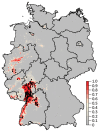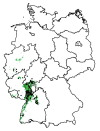Distribution of Usutu Virus in Germany and Its Effect on Breeding Bird Populations
- PMID: 29148399
- PMCID: PMC5708248
- DOI: 10.3201/eid2312.171257
Distribution of Usutu Virus in Germany and Its Effect on Breeding Bird Populations
Abstract
Usutu virus (USUV) is an emerging mosquitoborne flavivirus with an increasing number of reports from several countries in Europe, where USUV infection has caused high avian mortality rates. However, 20 years after the first observed outbreak of USUV in Europe, there is still no reliable assessment of the large-scale impact of USUV outbreaks on bird populations. In this study, we identified the areas suitable for USUV circulation in Germany and analyzed the effects of USUV on breeding bird populations. We calculated the USUV-associated additional decline of common blackbird (Turdus merula) populations as 15.7% inside USUV-suitable areas but found no significant effect for the other 14 common bird species investigated. Our results show that the emergence of USUV is a further threat for birds in Europe and that the large-scale impact on population levels, at least for common blackbirds, must be considered.
Keywords: Germany; Usutu virus; bird population decline; breeding birds; common blackbird; flavivirus; vector-borne infections.
Figures



Similar articles
-
Genomic monitoring to understand the emergence and spread of Usutu virus in the Netherlands, 2016-2018.Sci Rep. 2020 Feb 18;10(1):2798. doi: 10.1038/s41598-020-59692-y. Sci Rep. 2020. PMID: 32071379 Free PMC article.
-
Epidemic Spread of Usutu Virus in Southwest Germany in 2011 to 2013 and Monitoring of Wild Birds for Usutu and West Nile Viruses.Vector Borne Zoonotic Dis. 2015 Aug;15(8):481-8. doi: 10.1089/vbz.2014.1746. Vector Borne Zoonotic Dis. 2015. PMID: 26273809
-
Evidence for an independent third Usutu virus introduction into Germany.Vet Microbiol. 2016 Aug 30;192:60-66. doi: 10.1016/j.vetmic.2016.06.007. Epub 2016 Jun 16. Vet Microbiol. 2016. PMID: 27527765
-
An overview of Usutu virus.Microbes Infect. 2017 Jul-Aug;19(7-8):382-387. doi: 10.1016/j.micinf.2017.05.003. Epub 2017 Jun 8. Microbes Infect. 2017. PMID: 28602915 Review.
-
Usutu Virus: An Arbovirus on the Rise.Viruses. 2019 Jul 12;11(7):640. doi: 10.3390/v11070640. Viruses. 2019. PMID: 31336826 Free PMC article. Review.
Cited by
-
Differential pathogenesis of Usutu virus isolates in mice.PLoS Negl Trop Dis. 2020 Oct 12;14(10):e0008765. doi: 10.1371/journal.pntd.0008765. eCollection 2020 Oct. PLoS Negl Trop Dis. 2020. PMID: 33044987 Free PMC article.
-
Pathogenesis and shedding of Usutu virus in juvenile chickens.Emerg Microbes Infect. 2021 Dec;10(1):725-738. doi: 10.1080/22221751.2021.1908850. Emerg Microbes Infect. 2021. PMID: 33769213 Free PMC article.
-
Detection of Usutu, Sindbis, and Batai Viruses in Mosquitoes (Diptera: Culicidae) Collected in Germany, 2011⁻2016.Viruses. 2018 Jul 23;10(7):389. doi: 10.3390/v10070389. Viruses. 2018. PMID: 30041410 Free PMC article.
-
Antiviral Chemotherapy in Avian Medicine-A Review.Viruses. 2024 Apr 12;16(4):593. doi: 10.3390/v16040593. Viruses. 2024. PMID: 38675934 Free PMC article. Review.
-
Experimental Usutu virus infection in Eurasian blackbirds (Turdus merula).Npj Viruses. 2025 Jun 20;3(1):51. doi: 10.1038/s44298-025-00133-w. Npj Viruses. 2025. PMID: 40542200 Free PMC article.
References
MeSH terms
Supplementary concepts
LinkOut - more resources
Full Text Sources
Other Literature Sources

